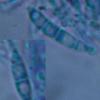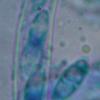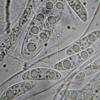
26-12-2025 21:19
Arnold BüschlenPithyella challaudii Pirou. Ist als Bryoparasit in

24-12-2025 17:08
Hulda Caroline HolteHello, I have found this propoloid ascomycete on

21-12-2025 09:32
Hello.A tiny ascomycete found embedded in wood in

21-12-2025 21:32
Pol DebaenstHello, Garden, Burgweg 19, Veurne, BelgiumOn 10/1

22-12-2025 23:38
Patrice TANCHAUDBonsoir, récolte sur un mur en pierre, apothéci
Ascocoryne.
Luc Bailly,
27-10-2009 16:31
Luc Bailly,
27-10-2009 16:35
Re:Ascocoryne.
... et parfois, j'ai des spores 1-septées comme chez A. sarcoides (il y a une paraphyse qui passe devant la spore). En outre, les dimensions sont intermédiaires.
Dois-je tout de même conclure sur A. cylichnium? Des intermédiaires entre les deux espèces sont-ils connus?
Pour info, c'est sur hêtre, les fructifications sont très mûres, et les prélèvements pour la micro viennent de la même partie d'une même fructification.
Votre avis?
Amitiés - Luc BAILLY.
Dois-je tout de même conclure sur A. cylichnium? Des intermédiaires entre les deux espèces sont-ils connus?
Pour info, c'est sur hêtre, les fructifications sont très mûres, et les prélèvements pour la micro viennent de la même partie d'une même fructification.
Votre avis?
Amitiés - Luc BAILLY.
Hans-Otto Baral,
27-10-2009 17:22

Re:Ascocoryne.
Without vital spores this question is hardly to answer. The confusion in Ascocoryne is simply the result of the fact that the literature has consequently been performed on dead material.
There do not exist any forms intermediate between A. sarcoides and A. cylichnium, instead the two species are very very distinct. But the still not validly described A. inflata is a close relative and could be the one you have. It is named for its strongly capitate paraphyses, did you look for them?
On the DVD I have a key on Ascocoryne which shows the relevant characters.
The septa can also be seen in water mounts when the spores are still alive. Then you can see the important oil drops. And by the way, Ascocoryne ejects spores always aseptate, septate spores are the result of a postmaturation process. A. cylichnium often has 5-6 septa while sarcoides and inflata max. 3 septa.
Zotto
There do not exist any forms intermediate between A. sarcoides and A. cylichnium, instead the two species are very very distinct. But the still not validly described A. inflata is a close relative and could be the one you have. It is named for its strongly capitate paraphyses, did you look for them?
On the DVD I have a key on Ascocoryne which shows the relevant characters.
The septa can also be seen in water mounts when the spores are still alive. Then you can see the important oil drops. And by the way, Ascocoryne ejects spores always aseptate, septate spores are the result of a postmaturation process. A. cylichnium often has 5-6 septa while sarcoides and inflata max. 3 septa.
Zotto
Luc Bailly,
27-10-2009 17:37
Hans-Otto Baral,
27-10-2009 17:40

Re:Ascocoryne.
That looks good! So cylichnium is completely excluded because of the two big oil drops (cylichnium is always multiguttulate).
A. inflata has rather small apothecia and is almost sessile, A. sarcoides usually much larger.
Zotto
A. inflata has rather small apothecia and is almost sessile, A. sarcoides usually much larger.
Zotto
Luc Bailly,
27-10-2009 18:13
Re:Ascocoryne.
So it's A. sarcoides. The apothecia's were quite large. Thanks, Zotto.


